Types of bicycle pedals & shoe compatibility guide
 If there’s one thing that causes beginner cyclists anxiety, it’s the overwhelming choice of pedals that are currently available, so I thought I’d write this article about the types of road and MTB pedals and their compatibility in the hopes that someone could learn something from it.
If there’s one thing that causes beginner cyclists anxiety, it’s the overwhelming choice of pedals that are currently available, so I thought I’d write this article about the types of road and MTB pedals and their compatibility in the hopes that someone could learn something from it.
First things first, the good news is that 98% of the pedals you can buy today are interchangeable with standard bicycle cranks. They prety much all use the 9/16″ x 20 tpi (threads per inch). That means you can swap the pedals on everything from a 5 year old childrens bike to a top of the line road racer or downhill bike. The only thing to remember is that the left pedal has reverse «left hand» threads; that means to tighten the pedal, you turn the pedal spindle anti-clockwise. Sheldon Brown explains the exceptions below:
If your bike uses old American-style one-piece cranks, you need the 1/2″ x 20 thread size. Some older French bikes used the 14 x 1.25 mm size. Pedals in that size are extinct, but you can tap the cranks out to fit standard 9/16 x 20 pedals. – Sheldon Brown.
There’s only one system that I know of which uses it’s own pedal/crank interface: the Vista integrated pedal/crankset. There are probably older designs as well but I imagine they have been superceded.
The real issue is whether the pedals are compatible with the shoes & cleats. Most manufacturers have their own pedal/cleat interface standard. The most popular pedals today are Shimano, Look, Speedplay, Time, Campagnolo and Crank Brothers. Less common pedals are made by Keywin and Bebop, for example, but there are others.
ROAD PEDALS:
Current road pedal cleats are attached with 3 bolts which are arranged in a standard triangular pattern popularised by Look. They have a bigger shoe-cleat interface than MTB shoes for better power-transfer and comfort when cycling long distances. The aim is to get your foot just hovering above the pedal axle, improving the bio-ergonomics of your pedalling circle & bettering performance. All this on-bike efficiency comes at the considerable expense of off-bike mobility. Try getting off the bike and walking around without looking like a stranded penguin (like you so often see at the end of major stage race). For this reason, people only tend to use road pedal systems if they don’t plan on getting off the bike and walking around much. The following modern road pedals systems can be used with all modern road shoes that have the triangular three-bolt cleat interface standard. However, none of the different brands of pedals use the same cleats, so they’re not interchangeable.
 LOOK DELTA: Look ‘Delta’ pedals are (or were) the most common type of road pedals. They usually have an aluminium alloy body and are quite heavy by today’s standards. While they are cheap, I don’t recommend these pedals because they have a relatively large ‘stack height’ (stack height = distance between centre of pedal spindle and shoe sole).
LOOK DELTA: Look ‘Delta’ pedals are (or were) the most common type of road pedals. They usually have an aluminium alloy body and are quite heavy by today’s standards. While they are cheap, I don’t recommend these pedals because they have a relatively large ‘stack height’ (stack height = distance between centre of pedal spindle and shoe sole).
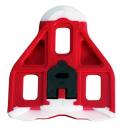 Black-coloured look delta cleats are fixed float (0° of movement); red cleats have 9° of free-float. Although this system is now superceded by Look Keo, you can still get replacement Delta cleats with a teflon insert. Look traditional delta pedals are not interchangeable with the newer Look Keo cleats!
Black-coloured look delta cleats are fixed float (0° of movement); red cleats have 9° of free-float. Although this system is now superceded by Look Keo, you can still get replacement Delta cleats with a teflon insert. Look traditional delta pedals are not interchangeable with the newer Look Keo cleats!
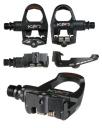 LOOK KEO: Pictured here are Look’s newest Keo model. They come in different varieties including an ‘easy’ model for beginners and a carbon/titanium version at the high end. Unlike most pedals which utilise a 15mm spanner for removal, all of the models of Look Keo have a hidden 8mm hidden allen socket bolt on the ends. This requires a matching 8mm allen key. While these low-profile pedals look nice on your road bike, I secretly dread these. Why? Because you run a big risk of cutting your hand open on dozens of sharp chainring teeth undoing the right-hand side pedal. The best way is to remove Keo pedals is position the right crank at the 4-5 O’Clock position (looking from the right side of the bike). Now walk around to the left side of the bike. Insert the allen key fully. Try and get the allen key horizontal (3 O’clock position from the left hand side of the bike). Standing up, you then press down with the tip of your toe firmly but slowly on the end of the allen key. Voila! Loose pedals as well as intact skin on hands & fingers!
LOOK KEO: Pictured here are Look’s newest Keo model. They come in different varieties including an ‘easy’ model for beginners and a carbon/titanium version at the high end. Unlike most pedals which utilise a 15mm spanner for removal, all of the models of Look Keo have a hidden 8mm hidden allen socket bolt on the ends. This requires a matching 8mm allen key. While these low-profile pedals look nice on your road bike, I secretly dread these. Why? Because you run a big risk of cutting your hand open on dozens of sharp chainring teeth undoing the right-hand side pedal. The best way is to remove Keo pedals is position the right crank at the 4-5 O’Clock position (looking from the right side of the bike). Now walk around to the left side of the bike. Insert the allen key fully. Try and get the allen key horizontal (3 O’clock position from the left hand side of the bike). Standing up, you then press down with the tip of your toe firmly but slowly on the end of the allen key. Voila! Loose pedals as well as intact skin on hands & fingers!
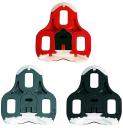 Look Keo cleats are available in red (9 degree float), gray (4.5 degree float) and black (fixed – no float). Teflon inserts are co-moulded where the cleats contact the pedals, reducing friction considerably. Likewise, Look Keo pedals are not interchangeable with the newer Look traditional delta cleats!
Look Keo cleats are available in red (9 degree float), gray (4.5 degree float) and black (fixed – no float). Teflon inserts are co-moulded where the cleats contact the pedals, reducing friction considerably. Likewise, Look Keo pedals are not interchangeable with the newer Look traditional delta cleats!
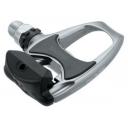
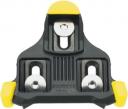 SHIMANO SPD-SL: The other type of Shimano road pedals commonly seen are called «SPD-SL». Contrary to what many people must think, SL is not a «Super Light» version of the normal SPD pedals -it’s an entirely different system altogether. SPD-SL pedals are designed for road use only. The cleats are made of a polymeric material and have three holes moulded into them.
SHIMANO SPD-SL: The other type of Shimano road pedals commonly seen are called «SPD-SL». Contrary to what many people must think, SL is not a «Super Light» version of the normal SPD pedals -it’s an entirely different system altogether. SPD-SL pedals are designed for road use only. The cleats are made of a polymeric material and have three holes moulded into them.
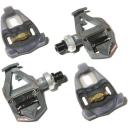 Time RXS/RXE pedals have become very popular owing to their good combination of low weight, low stack height, amount of free-float, considerable platform size, easy of exit & entry and cleats which last a considerably long time. These also use an 8mm allen key for installation and removal.
Time RXS/RXE pedals have become very popular owing to their good combination of low weight, low stack height, amount of free-float, considerable platform size, easy of exit & entry and cleats which last a considerably long time. These also use an 8mm allen key for installation and removal.
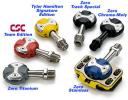 SPEEDPLAY ZERO: Speedplay pedals are the only road pedals to offer offer dual-sided entry. Speedplay Zero pedals provide 15° of adjustable free-float while the X-series provide up to 20° of free-float. They are a great lightweight pedal which are easy to get into and out of.
SPEEDPLAY ZERO: Speedplay pedals are the only road pedals to offer offer dual-sided entry. Speedplay Zero pedals provide 15° of adjustable free-float while the X-series provide up to 20° of free-float. They are a great lightweight pedal which are easy to get into and out of.
MTB PEDALS:
MTB pedal systems and other walkable clipless shoes utilise a smaller two-bolt arrangement and a miniaturised cleat. Some road shoes have both patterns drilled into their soles although there isn’t much point to using a MTB pedal on a road shoe, as it won’t have a recessed sole. You also won’t see a walkable MTB shoe compatible with the 3-bolt road cleats simply because road cleats are too big to recess into the soles. All of the following pedals can be used with MTB shoes, but none of the brands have the same cleats.
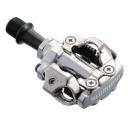
 SHIMANO SPD: There are two main types of SPD pedals, and both standards are not interchangeable. The ones pictured here that people have come to know and love are simply called SPD pedals. These are your bog-standard clipless pedal which haven’t changed one iota since I left highschool. These use a small, hard metal cleat with two screws, enabling the cleat to be recessed into the soles of cycling shoes. For this reason alone, SPD pedals are good for cycle-touring, because you can easily get off your bike and walk around without spraining your ankle. The majority of SPD pedals are also double sided. Sometimes though, you see some fancy single-sided ones with a normal flat pedal on the other side. The important thing to remember is that they have that tiny cleat…
SHIMANO SPD: There are two main types of SPD pedals, and both standards are not interchangeable. The ones pictured here that people have come to know and love are simply called SPD pedals. These are your bog-standard clipless pedal which haven’t changed one iota since I left highschool. These use a small, hard metal cleat with two screws, enabling the cleat to be recessed into the soles of cycling shoes. For this reason alone, SPD pedals are good for cycle-touring, because you can easily get off your bike and walk around without spraining your ankle. The majority of SPD pedals are also double sided. Sometimes though, you see some fancy single-sided ones with a normal flat pedal on the other side. The important thing to remember is that they have that tiny cleat…
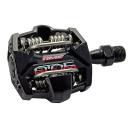 TIME ATAC: Although they are pretty heavy, they have the most positive retention of any pedal I have tried. You hear a single, well-defined “snap†upon each entry and exit. The feeling of security they provide is second to none, and I noticed it from the outset.
TIME ATAC: Although they are pretty heavy, they have the most positive retention of any pedal I have tried. You hear a single, well-defined “snap†upon each entry and exit. The feeling of security they provide is second to none, and I noticed it from the outset.
The zone where the cleat engages with the pedal is larger than with SPD pedals, so you never have to fumble about trying to find the entry point. Although I haven’t tested these in muddy conditions, they release whenever the need arises. All in all, I’d recommend this pedal system to anyone who wants a double-sided clipless pedal that you can easily walk in.
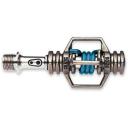 CRANK BROS EGGBEATER: These pedals have a very distinctive shape, hence the name. They are said to shed mud well, but I don’t find the platform all that supportive of my feet. They’re available in several versions with an ever-increasing subsitution of the steel parts for ones made from titanium. They’re certainly very lightweight but the top models are extremely pricey.
CRANK BROS EGGBEATER: These pedals have a very distinctive shape, hence the name. They are said to shed mud well, but I don’t find the platform all that supportive of my feet. They’re available in several versions with an ever-increasing subsitution of the steel parts for ones made from titanium. They’re certainly very lightweight but the top models are extremely pricey.
 The eggbeater candy pedals use the same bronze cleat common to all Eggbeater models. The cleats look almost the same as the ones used by Time ATAC, but they’re not interchangeable. Although these pedals provide better foot support than the standard versions, I found that the cleat slipped several times on the shoes used with plastic washers, preventing disengagement. This is a very dangerous scenario. so for that sole reason I stopped using them. If memory serves me correctly, the cleats could not be used without the washers in place due to inadequate cleat thickness.
The eggbeater candy pedals use the same bronze cleat common to all Eggbeater models. The cleats look almost the same as the ones used by Time ATAC, but they’re not interchangeable. Although these pedals provide better foot support than the standard versions, I found that the cleat slipped several times on the shoes used with plastic washers, preventing disengagement. This is a very dangerous scenario. so for that sole reason I stopped using them. If memory serves me correctly, the cleats could not be used without the washers in place due to inadequate cleat thickness.
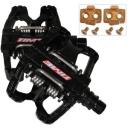 Which pedals should you buy? My favourite pedals are speedplay for road use and Time ATAC for mountainbiking. But each particular brand has their own devout followers for various reasons. Speedplay road pedals have the most float and are double sided. Shimano SPD-SL & Look road pedals offer a bigger platform to aid power transfer.
Which pedals should you buy? My favourite pedals are speedplay for road use and Time ATAC for mountainbiking. But each particular brand has their own devout followers for various reasons. Speedplay road pedals have the most float and are double sided. Shimano SPD-SL & Look road pedals offer a bigger platform to aid power transfer.
By far the most comprehesive look at pedals can be seen on Speedplay’s pedal history museum.

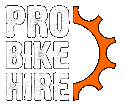
Discussion Area - Leave a Comment